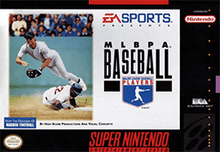MLBPA Baseball
| MLBPA Baseball | |
|---|---|
 Cover art (Super NES) | |
| Developer(s) |
High Score Productions Visual Concepts (SNES)[1] Beam Software (Game Gear) |
| Publisher(s) | |
| Director(s) | Happy Keller [1] |
| Platform(s) |
Super Famicom Mega Drive/Genesis Sega Game Gear |
| Release date(s) |
Super NES: Game Gear: |
| Genre(s) | Sports (professional baseball) |
| Mode(s) |
Single-player multiplayer |
MLBPA Baseball, known in Japan as Fighting Baseball (ファイティングベースボール Faitingu Besuboru, "Fighting Baseball"),[3] is a baseball video game for the Super NES, Mega Drive/Genesis, and Game Gear.
Summary
The game included the 1993 season's major league players and stats thanks to its MLBPA license, but could not use team names for lack of an MLB license. The game got around this by using the city names of each team with matching colors, and using terms "A League", "N League", and "The Series". Players are allowed to play a single game (with the default teams being Philadelphia at Toronto, the 1993 league champs), a full season based on the 1994 schedule (with wins and losses recorded by password in the SNES version, battery back-up for Genesis), playoffs, and a World Series. Though the full season mode is based on the 1994 schedule, it does NOT include the new (and current) three divisions/wild card format introduced for the 1994 season; instead it uses the old two division (per league) format.
Couched in what the packaging billed as "huge arcade style graphics," games could be played on either natural or artificial grass (depending on the home team) during day or night. The game also featured scoreboard animations for double and triple plays, home runs, grand slams, pitching changes, pinch hitters, and sometimes strike outs.
The SNES version is the first ever baseball video game to include the Atlanta Braves' distinctive Tomahawk Chop theme song, which is actually advertised on the back of the game box.
The game features former Major Leaguers Brent Gates of the Oakland Athletics and Billy Hatcher of the Boston Red Sox on the game's cover.
Reception
On release, Famicom Tsūshin scored the Super Famicom version of the game a 20 out of 40.[4] GamePro praised the easy controls, digitized voices, and the ability to control the ball after it leaves the pitcher's hand, but criticized the lack of real teams and the so-so graphics. They summarized it as an enjoyable game that falls short of ranking among the best in the genre.[5]
See also: other 1994 baseball games
- La Russa Baseball '95 - another Electronic Arts-published game
- Super Bases Loaded 3 - published by Jaleco
- Ken Griffey, Jr. Presents Major League Baseball - published by Nintendo
- World Series Baseball - published by Sega
- Tecmo Super Baseball - published by Tecmo
- RBI Baseball '94 - published by defunct company Tengen.
References
- 1 2 3 4 5 6 "Release information (Super NES)". GameFAQs. Retrieved 2008-05-15.
- ↑ "Release information (Game Gear)". GameFAQs. Retrieved 2012-07-07.
- ↑ "Japanese title". SuperFamicom.org. Retrieved 2012-07-28.
- ↑ NEW GAMES CROSS REVIEW: ファイティング ベースボール. Weekly Famicom Tsūshin. No.346. Pg.32. 4 August 1995.
- ↑ "A Major League Contender". GamePro (58). IDG. May 1994. p. 108.